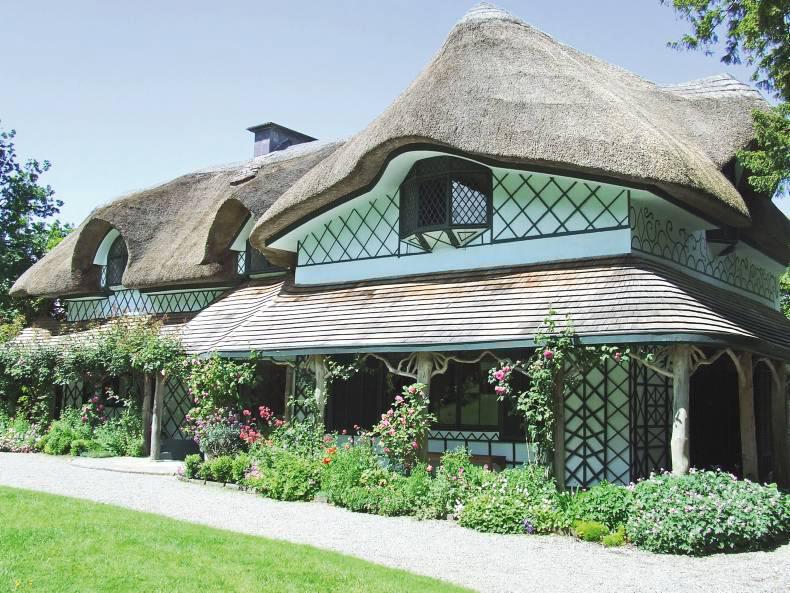I was staying with Dad in Tipperary for a few days and taking the opportunity to catch up with friends. I arranged to meet Ann in Cahir and we’d walk out to the Swiss cottage. Ann’s sister Margaret is one of the guides there.
What Ann didn’t know was that not only was I catching up with my friend, I was also revisiting some childhood memories. I attended boarding school in the Convent of Mercy, Cahir. The reason was that my grand aunt, Sister Elizabeth, was a nun in the convent.
On the third Sunday of the month we could have visitors from 3pm until 6pm or you could go down the town with your family. My family always included Aunt Lizzy and one of her favourite places to go was to the Swiss cottage. So we were regular visitors.
There were two elderly brothers there, Eugene and John Heavey. Eugene had bought the cottage for a nominal sum from the Land Commission in the 1960s. The two men lived in the cottage, as its caretakers. When we visited, we were welcomed into their home. Lizzy loved to chat with them and to show us off.
So as Ann and I followed the Coronation walk from Cahir, I was remembering the girl I was then. I would have been wearing my Sunday school uniform which made me self-conscious as I was obviously “a boarder from the convent”. The pathway runs along the banks of the Suir. On the other side is Cahir golf course with its manicured greens and lovely trees. It’s about a 30-minute walk to get to the bridge, over which one can access the cottage.
We stood and watched the brown trout jumping and then crossed over to take the steps to the cottage.
THE COTTAGE
The cottage is well secluded to afford privacy to the occupants. Once up the steps we entered via a tunnel which was the route the servants took so as not to disturb the activities of those who played above ground.
Lizzy would grab my hand in this white tunnel and her big rosary beads would be knocking gently among the folds of her black habit. Sister Lizzy was of the old school so she remained in the strict uniform of the 60s and 70s. She’d gather speed in anticipation of seeing the cottage and her friends.
One of the men wore glasses and was an avid reader. There were books piled everywhere and the other man loved to chat. Alas, I did not pay much attention so I don’t know which one was which.
The guides, Margaret, Mary and Karen, were busy at work. There was a constant trickle of visitors getting ready to take the tour of the cottage. Margaret gave us a great welcome and announced that she was guiding the next tour. She did so with assured confidence, imparting her factual knowledge. I know, from Ann, that she is a widely read lady and so ready to answer any question even remotely connected to the cottage or the surrounding area.
BACKGROUND
The Swiss cottage is one of the most romantic cottages in the world and one of the finest examples of an ornamental cottage. It was built in the early 19th century by Richard Butler, who was the 12th Lord Caher. The Butlers of Cahir were descendants of the Butlers of Ormond, whose domain stretched from Birr to Mitchelstown.
Richard had been raised in poverty. His mother was unaware that he was in line to become Lord Caher. Mrs Isabella Jeffereys of Blarney Castle saw an opportunity to secure a husband with title for her fourth daughter, Emily. She intervened and ensured that Richard was educated.
She then arranged for him to be married to Emily. The marriage in 1793 proved a success. Richard was 17 and Emily was 16.
The Swiss cottage was built as a place where one could visit and enjoy total privacy amid the beauty of nature. Sometimes it was opened to the community of Cahir. Folklore hints that it was built as a secluded haven for Lord Caher and his mistress.
Unique architecture
The architectural design is attributed to the famous regency architect, John Nash. Margaret explained that no two measurements are the same in the house – or indeed shapes. All this is based on the fact that everything is unique in nature and the cottage was designed to enhance the beauty of its location on the banks of the river, surrounded by woodland. It is indeed a magical cottage and the wallpaper in the Dufour Room stirred again my childhood memories of my visits to this place.
John Heavey died in 1980. Eugene moved away and the cottage fell into disrepair and was even vandalised. Restoration began in 1985 and in 1989 it opened to the public and in the care of the Office of Public Works (OPW). So whether you are old or young, there is something there for everyone
Protecting our heritage
There are 50 heritage sites around Ireland operated by the OPW and open to the public. There are varying admission fees and many of them are free. All except Kilkenny Castle offer free admission on the first Wednesday of every month during their opening seasons. It’s a great opportunity to see some of our special places and to catch up with a friend.
You can also purchase a Heritage Card which will give you unlimited admission, for one year, to sites managed by the OPW or the Department of Arts Heritage and the Gaeltacht. Consult the website for further information at www.heritageireland.ie. CL





SHARING OPTIONS